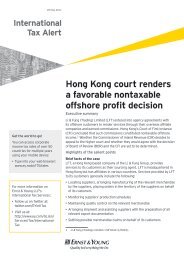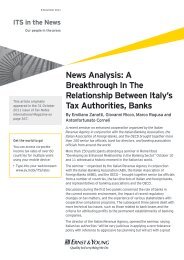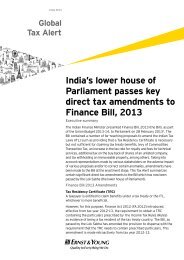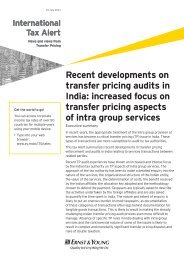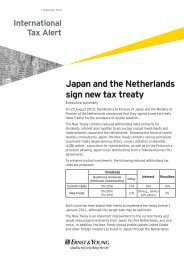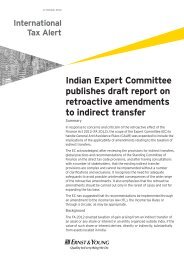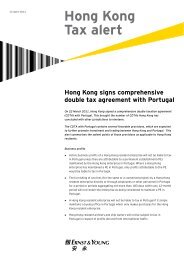Download - Ernst & Young T Magazine
Download - Ernst & Young T Magazine
Download - Ernst & Young T Magazine
Create successful ePaper yourself
Turn your PDF publications into a flip-book with our unique Google optimized e-Paper software.
Management Succession planning<br />
There are a number of factors that are driving<br />
companies to take succession more seriously.<br />
Increased competition is one. “It’s simply become<br />
harder for companies to succeed, in virtually every<br />
industry,” says Sadan. “It is imperative that<br />
companies recruit the best people. At the same<br />
time, they can’t afford to lose the best people.”<br />
Another factor is greater engagement at board<br />
level, which Sadan believes is largely due to the<br />
UK’s 2003 Higgs Report on the role and<br />
effectiveness of non-executive directors. Similarly,<br />
more chairmen are taking the issue seriously. “I<br />
think many of the new chairmen coming through<br />
now are much more proactive. They’ve all been<br />
CEOs in the past, or most of these new chairmen<br />
have been, and they understand this is crucial.”<br />
The increasing involvement of stakeholders is a<br />
further factor: investors do not like uncertainty,<br />
and CEO succession is receiving unprecedented<br />
scrutiny. In 2009, the US SEC, for example,<br />
proposed more transparency and shareholder<br />
disclosure about succession risk.<br />
While more companies are looking at succession<br />
more closely, many of those that do engage in<br />
succession planning are unhappy with the quality<br />
of their planning. Korn/Ferry’s research suggests<br />
that less than 1 in 10 UK business leaders, for<br />
example, rate their own company’s succession<br />
planning practices as ”excellent.” So what<br />
elements constitute best practice here?<br />
1. Start the succession process early<br />
The first element is that succession planning<br />
can’t be started too early. “The succession<br />
process is never-ending,” says Gorbanovskaya.<br />
“The best companies view this as an ongoing,<br />
real-time process. Companies should try and<br />
create a self-renewing succession culture that<br />
develops leaders at all levels.”<br />
Khurana points out that succession is not a<br />
punctuated event. “Succession is a process that<br />
should be part of board-level discussions<br />
throughout the year. Leadership development is<br />
not a decision to be made in weeks, but something<br />
to be made over years,” he says. “In really good<br />
companies, it’s something that boards get involved<br />
in years in advance of the tenure of the CEO.”<br />
2. Focus on strategy, not personalities<br />
Any well-planned succession should start with a<br />
thorough review of the business strategy, says<br />
Gorbanovskaya. Unfortunately, this rarely<br />
happens. Khurana’s research suggests that<br />
boards often start thinking about the people<br />
first: “Too often it ends up being a contest of<br />
personalities,” he says. “Companies should first<br />
think about the company’s strategic direction,<br />
and only then think about the necessary skills<br />
and backgrounds of the leadership team, not<br />
only the CEO, that are going to be needed to<br />
meet those challenges.”<br />
Furthermore, moving away from a focus on<br />
skills – assessing people against the strategy and<br />
the skills that you’re looking for – can unduly<br />
magnify the strengths of outsider candidates,<br />
while discounting weaknesses, argues Khurana.<br />
This helps explain why many companies turn to<br />
external CEOs, which can be risky. A study by AT<br />
Kearney on S&P 500 companies in the US,<br />
between 1988 and 2007, identified 36 highperforming<br />
companies and argued that much of<br />
their success was due to “home grown” talent.<br />
Gorbanovskaya notes that one of the main CEO<br />
succession challenges concerns the reluctance of<br />
current leaders to create a strong pool of<br />
candidates to replace them. To counter this, she<br />
recommends creating a blend of material and<br />
non-material incentives for current leaders to put<br />
succession planning on their agenda. To ensure<br />
this is embedded, it can be formalized within a<br />
management scorecard and linked to a significant<br />
part of an executive’s bonus (in certain cases, up to<br />
30% of the total).<br />
3. Give HR a seat at the table<br />
Somewhat surprisingly, HR is all too often<br />
excluded from the process, and merely treated<br />
as a support function. Khurana notes that the<br />
best companies respect the importance of HR<br />
and invest very deeply in their internal<br />
development process. “If you look at successful<br />
companies HR is seen as key to the company’s<br />
success. They spend a lot of time and attention<br />
on developing people,” he says.<br />
Companies that realize the importance of<br />
talent give HR a major role. “The head of HR is<br />
usually treated as equivalent to functions like<br />
chief financial officer. In these companies, HR is<br />
given a seat at the table in succession<br />
discussions and is integral to the process,” he<br />
says.<br />
4. Define the role of external recruiters<br />
External consultants and recruiters often play an<br />
important role in sourcing a new CEO. But some<br />
worry that companies expect too much from the<br />
executive search firms. Khurana believes that<br />
the roles of the search committee and external<br />
recruiters need to be clearly distinguished. A<br />
good search committee needs people with a<br />
deep understanding of the context and the<br />
functional backgrounds and requirements for<br />
senior positions, and who are cognizant of their<br />
own biases. For example, one bias to overcome is<br />
that of the stereotype CEO, to ensure a broader<br />
variety of candidates is attracted. “There’s a<br />
dangerous ’ideal form’ as to what a CEO should<br />
look like,” says Khurana. “It’s typically a male<br />
who’s over six feet tall and of European descent.<br />
In the global world, those biases will kill you.”<br />
One thing is certain. Given the changing<br />
balance of the global economy, the future<br />
stereotype of a CEO is sure to include an executive<br />
with considerable experience in rapid growth<br />
markets. Being able to demonstrate an<br />
understanding of the diversity between different<br />
cultures and a global mindset will be essential for<br />
tomorrow’s CEOs.<br />



